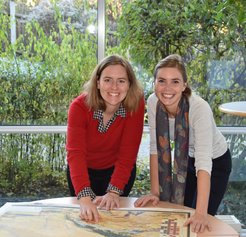The Hidden Bacterial Legacy of Ancient Cultures
Dr. Jessica Hendy and Dr. Christina Warinner win the 200,000 € Annual Donation Award of the Max Planck Society

Today, microbes tend to have a bad reputation, with many people associating them only with disease and illness. However, many microbes are beneficial and play an integral role in diverse aspects of everyday life - and in particular in our cuisine. In fact, it is only with the help of bacteria and yeasts that many of our most cherished foods and beverages, such as cheese, beer, and bread, are produced.
The range of bacterial species used in dairy production is particularly diverse and accounts for the enormous variety of tastes, textures and aromas in dairy products ranging from mild yoghurts to pungent cheeses. However, despite the importance of dairy microbes in many everyday foods, as well as growing interest in probiotics, or “good bacteria”, very little is known about their origins and evolution through time. This knowledge gap is exacerbated by the fact that traditional methods of dairying are increasingly disappearing in the wake of twenty-first century food globalization and industrialization: As traditional dairying practices vanish, the unique ‘heirloom’ bacteria that humans have unknowingly cultivated and propagated since prehistory are also being lost at an alarming rate - a kind of ‘microbial extinction’.
Warinner’s and Hendy’s project, “Heirloom Microbes: The History and Legacy of Ancient Dairying Bacteria,” sets out to counteract this trend and to shed light on the evolution of not only dairying bacteria themselves but also the human populations that culture, maintain, and digest them. Combining expertise in archaeology, nutrition, genetics, microbiology, and microbiome sciences, the ‘Heirloom Microbes’ project seeks to identify, study, and preserve the microbes used in non-industrial, traditionally made dairy products in three disparate world regions where dairy products form a central part of traditional cuisine and (food) culture: Europe (Germany), Central Asia (Mongolia), and the Middle East (Jordan).
Given that dairying has taken place in these regions for hundreds, and perhaps thousands, of years, Warinner and Hendy will then turn their attention to the ancient past. The adoption of dairy foods into the adult diet, and the evolution of lactase persistence (the genetic ability to drink milk in adulthood), is one of the clearest examples of how genes and culture interact. However, despite milk’s undisputed importance, it is not well understood how this evolution occurred. It is assumed that prior to the evolution of human lactase persistence, milk must have been heavily processed to avoid the symptoms of lactose intolerance, and dairy microbes likely played a key role in converting this inaccessible liquid into a food source that was both digestible and nutritious.
To shed light on one of the most interesting chapters of human evolution, the ‘Heirloom Microbes’ project will use recent advances in genomics and proteomics to identify traces of milk and dairy microbes on archaeological pots and in ancient tooth tartar (dental calculus). This will then allow Hendy and Warinner to illuminate questions about how and why these products were powerful enough to shape both the human genome and millennia of culinary practices.
